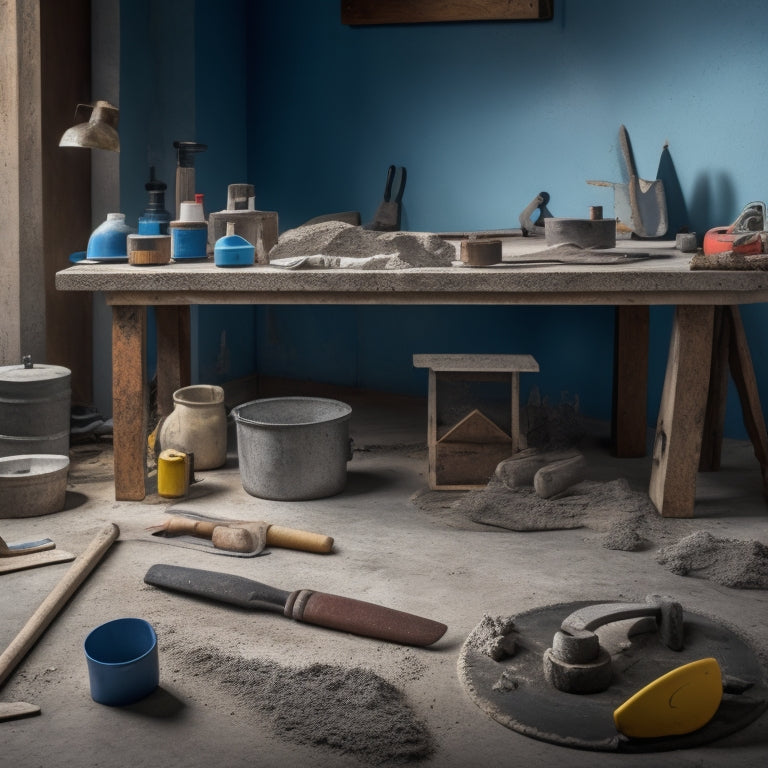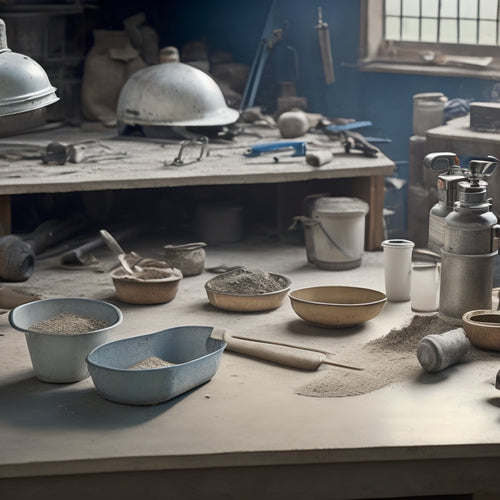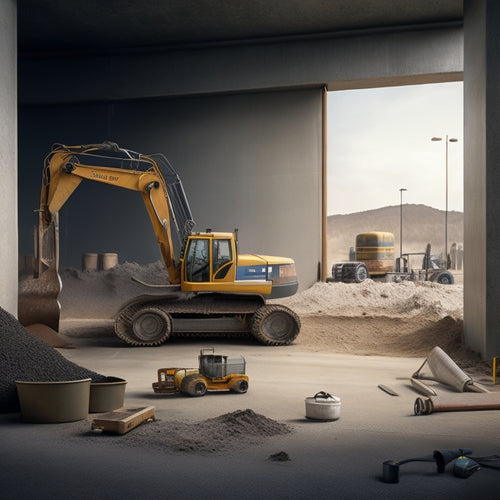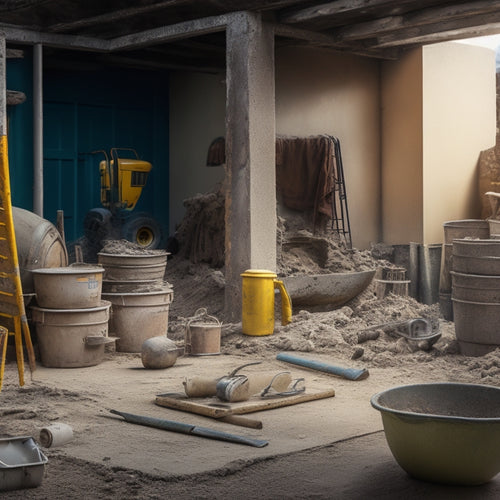
What Tools Do You Need for DIY Concrete Finishing
Share
You'll need a range of tools to achieve professional-looking DIY concrete finishing results. For power tools, consider a rotary hammer drill, grinder/polisher, and unique textures for varied finishes. Essential drilling and mixing tools like a heavy-duty drill, cordless drill, mixing bucket, and mixing paddle attachment will also come in handy. Specialized smoothing tools, including a bull float, darby/tamping tool, power trowel, and edging tools, will help you achieve a high-gloss finish. Additionally, don't forget about cutting and shaping tools, like concrete saws and diamond blades, as well as safety equipment and accessories. Now, get ready to refine your skills and take your concrete finishing to the next level.
Key Takeaways
• A rotary hammer drill is essential for breaking up and removing excess material in concrete finishing.
• A grinder/polisher is necessary for refining the surface, removing imperfections, and achieving a high-gloss finish.
• A bull float, darby/tamping tool, and power trowel are required for leveling, smoothing, and finishing freshly poured concrete.
• Safety equipment, including protective gear, safety protocols, and a first aid kit, is crucial for a safe and successful DIY concrete finishing project.
• Specialized tools, such as concrete saws, diamond blades, and decorative edging tools, are necessary for cutting, shaping, and customizing concrete designs.
Power Tools for Cinder Block Finishing
When finishing cinder blocks, you'll need to invest in the right power tools to achieve a smooth, even surface. A rotary hammer drill is often the first tool to reach for. This powerful device is capable of breaking up and removing excess material, allowing you to achieve a variety of cinder block textures. With the right bit attachment, you can create a rough, exposed aggregate finish or a smooth, polished surface.
For more advanced finishing techniques, consider investing in a grinder or a polisher. These tools allow you to refine the surface of your cinder blocks, removing imperfections and leaving a high-gloss finish. With a grinder, you can also create unique textures and patterns, adding visual interest to your project.
Essential Drilling and Mixing Tools
You'll need a reliable drill and mixing bucket to prepare and apply your concrete, so invest in a heavy-duty drill with a high torque setting and a sturdy mixing bucket that can withstand the rigors of mixing heavy concrete.
When it comes to drill types, consider a cordless drill with a high-torque setting for maximum power and flexibility. This will allow you to mix large batches of concrete efficiently.
For mixing techniques, start by adding the dry ingredients to the mixing bucket, followed by the wet ingredients. Use a slow, circular motion to combine the ingredients, gradually increasing the speed as the mix thickens.
A mixing paddle attachment can be a valuable addition to your drill, allowing you to mix large batches with ease. Make sure to choose a paddle that's designed for heavy-duty use and can withstand the rigors of mixing concrete.
With the right drill and mixing bucket, you'll be able to prepare and apply your concrete with confidence, ensuring a smooth and even finish.
Specialized Tools for Smoothing
With a solid foundation in drilling and mixing, it's time to focus on the specialized tools that'll help you achieve a smooth, even finish.
You'll need a range of tools to master various smoothing techniques, from simple to advanced. A bull float is essential for leveling and smoothing out freshly poured concrete. It's ideal for large areas and helps remove air pockets and excess water.
For more precise control, use a darby or tamping tool to flatten and smooth the surface. A power trowel is also a game-changer, allowing you to achieve a high-gloss finish with minimal effort.
Don't forget to invest in a set of edging tools, such as edgers and jointers, to create crisp, clean lines and edges. Finally, consider investing in specialized finishing products, like concrete retarders or accelerators, to customize your finishing process.
Cutting and Shaping Concrete Tools
Cutting and shaping concrete tools give you the precision and control to create complex designs, make repairs, and even salvage damaged slabs. With the right tools, you can master various concrete cutting and shaping techniques to achieve the desired outcome.
Here are some essential tools you'll need:
-
Concrete saws: These powerful tools are designed for heavy-duty concrete cutting. They come in various sizes and types, including walk-behind saws, handheld saws, and circular saws.
-
Diamond blades: These blades are specifically designed for concrete cutting and are available in different sizes and types. They're ideal for making precise cuts and can be used with various power tools.
-
Concrete chisels and hand sets: These manual tools are perfect for shaping and removing small areas of concrete. They're also great for making repairs and creating decorative edges.
Safety Equipment and Accessories
Protecting yourself from the hazards of concrete finishing is essential, so outfit yourself with the necessary safety equipment and accessories before starting any project.
You'll need protective gear such as gloves, safety glasses, and a dust mask to shield yourself from concrete dust, debris, and harsh chemicals. A pair of steel-toed boots and long pants will also protect your feet and legs from heavy objects and sharp edges.
Develop safety protocols to guarantee you're working safely and efficiently. For instance, establish a clean and organized workspace, and designate a specific area for mixing and applying concrete.
Make sure you have a first aid kit on hand and know what to do in case of an emergency. Additionally, consider investing in a respirator or ventilation system to minimize exposure to airborne particles.
Frequently Asked Questions
Can I Use a Regular Drill for Mixing Concrete?
You're wondering if a regular drill can handle mixing concrete? Honestly, it's not the best choice. The intense mixing techniques required for concrete can burn out your drill's motor quickly.
Instead, consider drill alternatives like a heavy-duty mixer or a dedicated concrete mixing drill. These tools are designed to handle the thick, heavy mix, and will save you time and effort in the long run.
How Do I Prevent Rust on My Concrete Finishing Tools?
'An ounce of prevention is worth a pound of cure' - especially when it comes to your concrete finishing tools.
You'll save time and money by taking care of them.
To prevent rust, clean your tools thoroughly after each use, dry them with a towel, and apply a rust-inhibiting coating or oil.
Store them in a dry place, away from direct sunlight.
Regular tool maintenance is key to extending their lifespan and ensuring they remain in top condition for your next project.
Can I Rent Concrete Finishing Tools Instead of Buying?
You're considering renting concrete finishing tools instead of buying, and that's a smart move.
Renting can be a cost-effective option, especially if you're only working on a small project.
Compare the rental fees to the purchase price of the tools you need, and calculate how many times you'd need to rent to break even.
If you won't be using the tools frequently, renting might be the way to go, saving you money and storage space.
Do I Need a Permit for DIY Concrete Finishing Projects?
Before diving into your DIY concrete finishing project, you'll need to determine if you need a permit.
Check with your local government to understand permit requirements, as they vary depending on the project's scope and location.
Review project guidelines to guarantee compliance, and don't assume a permit isn't necessary just because it's a small project.
You'll avoid costly delays and potential fines by doing your due diligence upfront.
Can I Finish Concrete in Cold or Wet Weather Conditions?
As you step into the chilly or soggy fray, remember that concrete finishing is a delicate dance.
When working in cold weather, you'll need to employ special techniques to prevent frost damage and guarantee proper curing.
Wet weather challenges are just as overwhelming, requiring you to adapt your strategy to minimize water seepage and staining.
Don't let the elements get the best of you - gear up with the right knowledge and tools to tame the temperamental beast that's concrete.
Conclusion
You've made it to the finish line – literally. With the right tools, you've transformed your DIY concrete project from a rough, uninviting slab to a sleek, modern masterpiece.
As the ancient Greek philosopher, Aristotle, once said, 'We are what we repeatedly do. Excellence, then, isn't an act, but a habit.' With practice and patience, you'll be a concrete finishing pro in no time.
So, get ready to take on the next project, and remember, the devil is in the details – or in this case, the finish.
Related Posts
-

What Tools Do You Need for Concrete Success
For concrete success, you'll need a range of essential power tools, including rotary hammers, angle grinders, concret...
-

Why You Need Affordable Concrete Wall Construction Tools
You need affordable concrete wall construction tools to guarantee a profitable project, as the cost of equipment can ...
-

What Tools Are Needed for Concrete Wall Foundations
You'll need a thorough array of tools and equipment to construct a concrete wall foundation that meets structural int...


